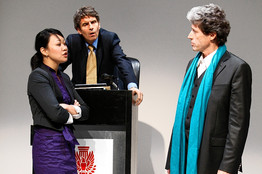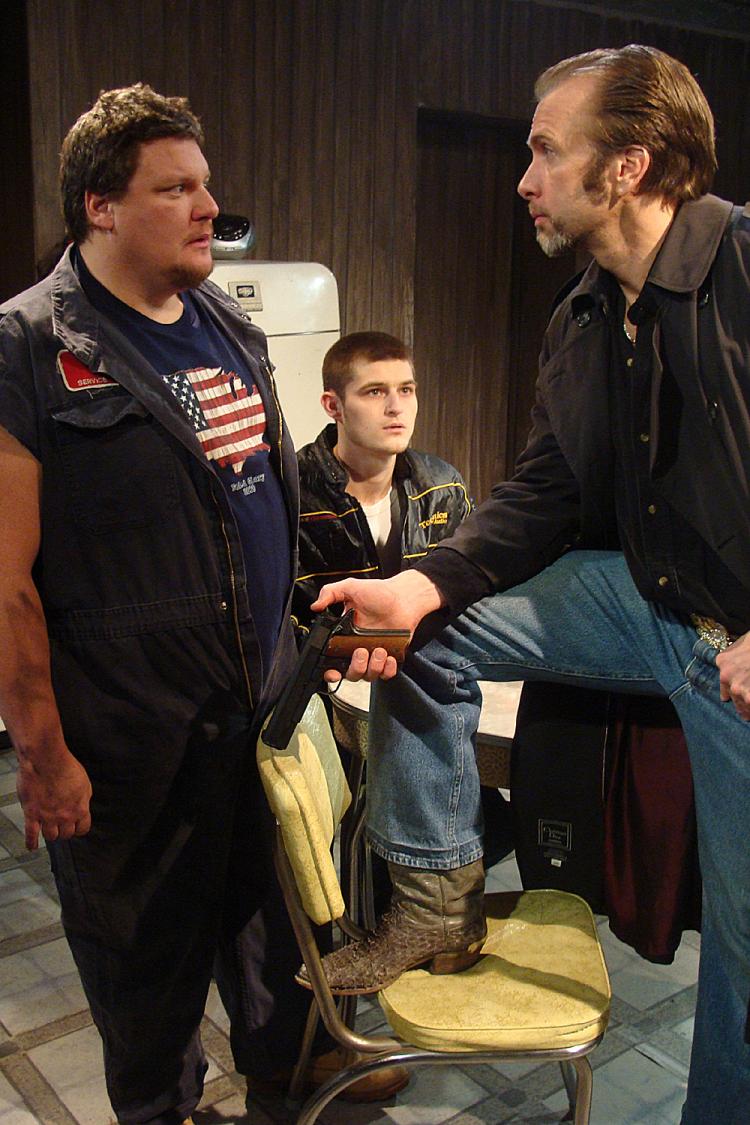“Actors and directors are not, generally speaking, well qualified for any other job; most hit on their vocations precisely because they seemed no good for anything else. This is the moment at which character and power of endurance–what the Victorians used to call ‘bottom’–becomes almost as important as talent, and much more important than luck.”
Simon Callow, Orson Welles: Hello Americans
Archives for May 2010
TT: Not in my front yard
In the New York edition of today’s Wall Street Journal, I review The Bilbao Effect, Oren Safdie’s new play about the splendors and miseries of postmodern starchitecture. Here’s an excerpt.
* * *
Architecture is the only art form about which everybody has an opinion–because everybody has to live with it. Some buildings, however, are harder to live with than others, and in recent years a growing number of them have been the work of big-name “starchitects” who appear at times to be more interested in making a splash than ensuring the day-to-day livability of their buildings. Enter Oren Safdie, the son of the famous modernist architect Moshe Safdie, who in 2003 wrote a witty and knowing play called “Private Jokes, Public Places” in which he ran a sharp skewer through the pretensions of a generation of starchitects who give the impression of having forgotten that human beings live in and near the buildings they design….
 Now Mr. Safdie is back at the Center for Architecture with a sequel, “The Bilbao Effect,” in which the principal characters from “Private Jokes, Public Places” return to the stage to conduct a furiously farcical debate over the wholly serious subject of the architect’s responsibility to the people whose lives he touches.
Now Mr. Safdie is back at the Center for Architecture with a sequel, “The Bilbao Effect,” in which the principal characters from “Private Jokes, Public Places” return to the stage to conduct a furiously farcical debate over the wholly serious subject of the architect’s responsibility to the people whose lives he touches.
The play’s title is, of course, a nod to Frank Gehry’s 1997 branch of the Guggenheim Museum in Bilbao, Spain, an avant-garde building so self-consciously spectacular that it has become a tourist attraction in its own right. Its success persuading other institutions to undertake the construction of equally over-the-top structures in the hopes of drawing visitors whose spending will galvanize the local economy and enhance their own bottom lines. In “The Bilbao Effect,” Mr. Safdie imagines that Staten Island’s city fathers have succumbed to a similar case of architectural hubris and allowed the egomaniacal Erhardt Shlaminger (Joris Stuyck) of “Private Jokes, Public Places” to build a Gehry-like urban-renewal project in the middle of town….
Good plays of ideas allow the audience to make up its own mind about the relative merits of the characters’ arguments. One of the best things about “Private Jokes, Public Places” was Mr. Safdie’s willingness to let everyone look stupid at one time or another, whereas in “The Bilbao Effect” Schlaminger and his smug lawyer (John Bolton) are too obviously the villains of the piece.
All this notwithstanding, “The Bilbao Effect” is both funny and cruelly smart in its portrayal of the lunatic excesses of the more extreme varieties of starchitecture. Perhaps the shrewdest of Mr. Safdie’s touches is the way in which he conceives of the debate over such architecture as a class war…
* * *
Read the whole thing here.
TT: Not quite at our picture-perfect best
As some of you are aware, my recent visit to Chicago was a bit on the stressful side. Mrs. T was laid low with gallstones a week ago, thus necessitating an emergency-room visit and a stay at Northwestern Memorial Hospital. We are immensely grateful to the staffs of both Northwestern and the Hyatt Regency, who knew exactly what to do when I called the switchboard at two a.m. and asked for the address of the nearest hospital.
We returned to the East Coast last Friday on schedule, and Mrs. T is now resting more or less comfortably up in Connecticut as we wait for her doctors there to decide what they want to do next. I’ll keep you posted.
TT: Almanac
“He had crashed through the barrier. He had stopped worrying and started relaxing. He was up on that plateau where you just did whatever needed doing. I knew that place. I lived there.”
Lee Child, Killing Floor
TT: Blood simpler
Today’s Wall Street Journal drama column is the first in a series of reports about my recent visit to Chicago. This week I review Profiles Theatre’s production of Tracy Letts’ Killer Joe and the Strawdog Theatre Company’s production of Bertolt Brecht’s The Good Soul of Szechuan. Both shows were memorable. Here’s an excerpt.
* * *
No matter how unshockable you like to think you are, I expect you’ll jump at least once–and probably several times–in the course of Profiles Theatre’s scaldingly funny revival of “Killer Joe,” the play that made Tracy Letts a big name in American theater 14 years before “August: Osage County” reached Broadway.
 First performed in 1993, “Killer Joe” is a blacker-than-black comedy about a shiftless drug dealer (Kevin Bigley) who hires an obliging off-duty cop (Darrell W. Cox) to murder his mother, offering the favors of his unwitting kid sister (Claire Wellin) as a down payment on the cop’s chunk of the money from the mother’s life-insurance policy. The events that flow from this transaction, all of which take place in a grubby house trailer somewhere on the outskirts of Dallas, are portrayed with extreme explicitness, up to and including in-your-face nudity and the kind of bloodshed you might expect to see in the back room of a butcher’s shop on a busy day. If any part of that description strikes you as offputting, stay home and watch a sitcom–but you’ll be missing a fabulously well-staged production of one of the best American plays of the past quarter-century….
First performed in 1993, “Killer Joe” is a blacker-than-black comedy about a shiftless drug dealer (Kevin Bigley) who hires an obliging off-duty cop (Darrell W. Cox) to murder his mother, offering the favors of his unwitting kid sister (Claire Wellin) as a down payment on the cop’s chunk of the money from the mother’s life-insurance policy. The events that flow from this transaction, all of which take place in a grubby house trailer somewhere on the outskirts of Dallas, are portrayed with extreme explicitness, up to and including in-your-face nudity and the kind of bloodshed you might expect to see in the back room of a butcher’s shop on a busy day. If any part of that description strikes you as offputting, stay home and watch a sitcom–but you’ll be missing a fabulously well-staged production of one of the best American plays of the past quarter-century….
If you doubt that it’s possible to write a political play that is both passionate and poetic, I offer in evidence Bertolt Brecht’s “The Good Soul of Szechuan,” a parable of capitalism and its discontents that the Strawdog Theatre Company is performing with an exciting blend of fire, fantasy and irreverence.
The last of these qualities is especially important when it comes to the plays of Brecht, which are too often directed so didactically that they become stiff. Not this time: Shade Murray’s deceptively casual staging has the helter-skelter feel of a frat party whose guests have decided on the spur of the moment to put on a show. As you enter the black-box theater, a gaggle of musicians in the corner of the room are singing songs by Neil Young and Leonard Cohen. Then, almost without warning, the play gets underway, and before you know it, you’re swept up in the tale of a Chinese village whose most spiritually minded citizen is a whore with a heart of 10-karat gold (Michaela Petro, who is terrific). Shen Te has come under the scrutiny of a trio of credulous gods who decide to reward her for her goodness, thereby triggering the law of unintended consequences and bringing about a sequence of dire and farcical events that are portrayed with great gusto by Mr. Murray’s fine cast….
* * *
Read the whole thing here.
TT: Picking the winners
In Theatre, his new book, David Mamet lists his ten favorite American plays and explains why he likes them so much. The list, as I observed the other day, is full of surprises, but it’s interesting for another reason, which is that it tells the reader at least as much about Mamet himself as it does about the plays he picked. That’s almost always true of what I call “practitioner criticism,” in which a working artist doubles as a critic of the art form that he practices.
So what do we learn about the author of Glengarry Glen Ross from the fact that Our Town is his favorite American play? To find out, pick up a copy of Saturday’s Wall Street Journal and read my “Sightings” column, in which I speculate–fruitfully, I hope–on the insights that David Mamet’s top-ten list offers into his theatrical psyche.
UPDATE: Read the whole thing here.
TT: Almanac
“There is something beautiful, touching and poetic when one person loves more than the other, and the other is indifferent.”
Anton Chekhov, “After the Theatre”
TT: So you want to see a show?
Here’s my list of recommended Broadway, off-Broadway, and out-of-town shows, updated weekly. In all cases, I gave these shows favorable reviews (if sometimes qualifiedly so) in The Wall Street Journal when they opened. For more information, click on the title.
Warning: Broadway shows marked with an asterisk were sold out, or nearly so, last week.
BROADWAY:
• La Cage aux Folles * (musical, PG-13, adult subject matter, reviewed here)
• Fela! (musical, PG-13, adult subject matter, reviewed here)
• Fences * (drama, PG-13/R, adult subject matter, closes July 11, reviewed here)
• God of Carnage (serious comedy, PG-13, adult subject matter, closes June 27, reviewed here)
• Million Dollar Quartet (jukebox musical, G, reviewed here)
• South Pacific (musical, G/PG-13, some sexual content, brilliantly staged but unsuitable for viewers acutely allergic to preachiness, closes Aug. 22, reviewed here)
OFF BROADWAY:
• Alfred Hitchcock’s The 39 Steps (comedy, G, suitable for bright children, original Broadway production reviewed here)
• Avenue Q (musical, R, adult subject matter and one show-stopping scene of puppet-on-puppet sex, reviewed here)
• The Fantasticks (musical, G, suitable for children capable of enjoying a love story, reviewed here)
• The Glass Menagerie (drama, G, too dark for children, closes June 13, reviewed here)
• Our Town (drama, G, suitable for mature children, reviewed here)
CLOSING SOON ON BROADWAY:
• A Behanding in Spokane (black comedy, PG-13, violence and adult subject matter, closes June 6, reviewed here)
CLOSING SOON OFF BROADWAY:
• Doctor Knock, or The Triumph of Medicine (satire, G, not easily accessible to children, closes June 6, reviewed here)
• The Temperamentals (drama, PG-13, adult subject matter, closes May 30, reviewed here)
